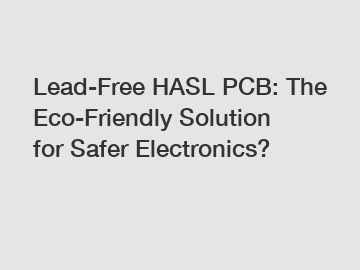Lead-Free HASL PCB: The Eco-Friendly Solution for Safer Electronics?
Lead-Free HASL PCB: The Eco-Friendly Solution for Safer Electronics.
In recent years, there has been a growing concern regarding the use of hazardous materials in electronic products. Lead, in particular, has been extensively used in the past in the manufacturing of printed circuit boards (PCBs). However, due to its harmful effects on both human health and the environment, there has been a shift towards lead-free alternatives. Among them, Lead-Free Hot Air Solder Leveling (HASL) PCBs have emerged as a popular choice for manufacturers. This article will explore the benefits of lead-free HASL PCBs and their contribution to creating a safer and more sustainable electronic industry.
Eliminating Lead from PCBs:

1. Health Hazards:
- Lead exposure through PCBs has been linked to severe health issues such as neurological disorders, developmental delays, and reproductive problems.
- Children and pregnant women are particularly vulnerable to lead exposure.
2. Environmental Impact:
- Lead contamination can occur during the manufacturing, disposal, or recycling processes of PCBs, leading to soil and water pollution.
- E-waste often ends up in landfills, posing a threat to both the environment and human health.
The Rise of Lead-Free HASL PCBs:
1. Safer Alternative:
- Lead-free HASL PCBs eliminate the risks associated with lead exposure, making electronic devices safer for both manufacturers and end-users.
- The adoption of lead-free PCBs aligns with international regulations and standards for hazardous substance restrictions, such as the Restriction of Hazardous Substances (RoHS) directive.
2. Environmental Advantages:
- By eliminating lead, the production and lifecycle of lead-free HASL PCBs significantly reduce environmental pollution.
- When disposed of properly, lead-free PCBs can be recycled, minimizing the need for raw materials and reducing waste.
Benefits of Lead-Free HASL PCBs:
1. Reliability:
- Lead-free HASL PCBs provide excellent solderability and good thermal resistance, ensuring high reliability and long-term performance of electronic devices.
- These PCBs have become the preferred choice in many industries, including automotive, aerospace, and medical, where reliability and safety are critical.
2. Cost-Effective:
- While the initial cost of lead-free HASL PCBs may be slightly higher, their long-term benefits outweigh the investment.
- The reduction in the use of hazardous materials translates into lower manufacturing costs and compliance with regulations, making these PCBs a cost-effective solution.
3. Compatibility:
- Lead-free HASL PCBs maintain the same compatibility with existing PCB production processes and equipment as their lead-based counterparts.
- This allows manufacturers to transition to lead-free alternatives without major modifications or disruptions in their operations.
Conclusion:
The shift towards lead-free HASL PCBs represents a significant step in the direction of a safer and more sustainable electronic industry. By eliminating lead, these PCBs ensure the health and well-being of both manufacturers and end-users while reducing environmental pollution. Furthermore, the reliability, cost-effectiveness, and compatibility of lead-free HASL PCBs make them a viable alternative for a wide range of industries. Embracing this eco-friendly solution is not only essential for compliance with regulations but also demonstrates a commitment to a healthier and more sustainable future.
For more information or assistance with lead-free HASL PCBs, please do not hesitate to contact us.
If you want to learn more, please visit our website hasl lead free, immersion tin 4layer , Lead Free HASL PCB .

Comments